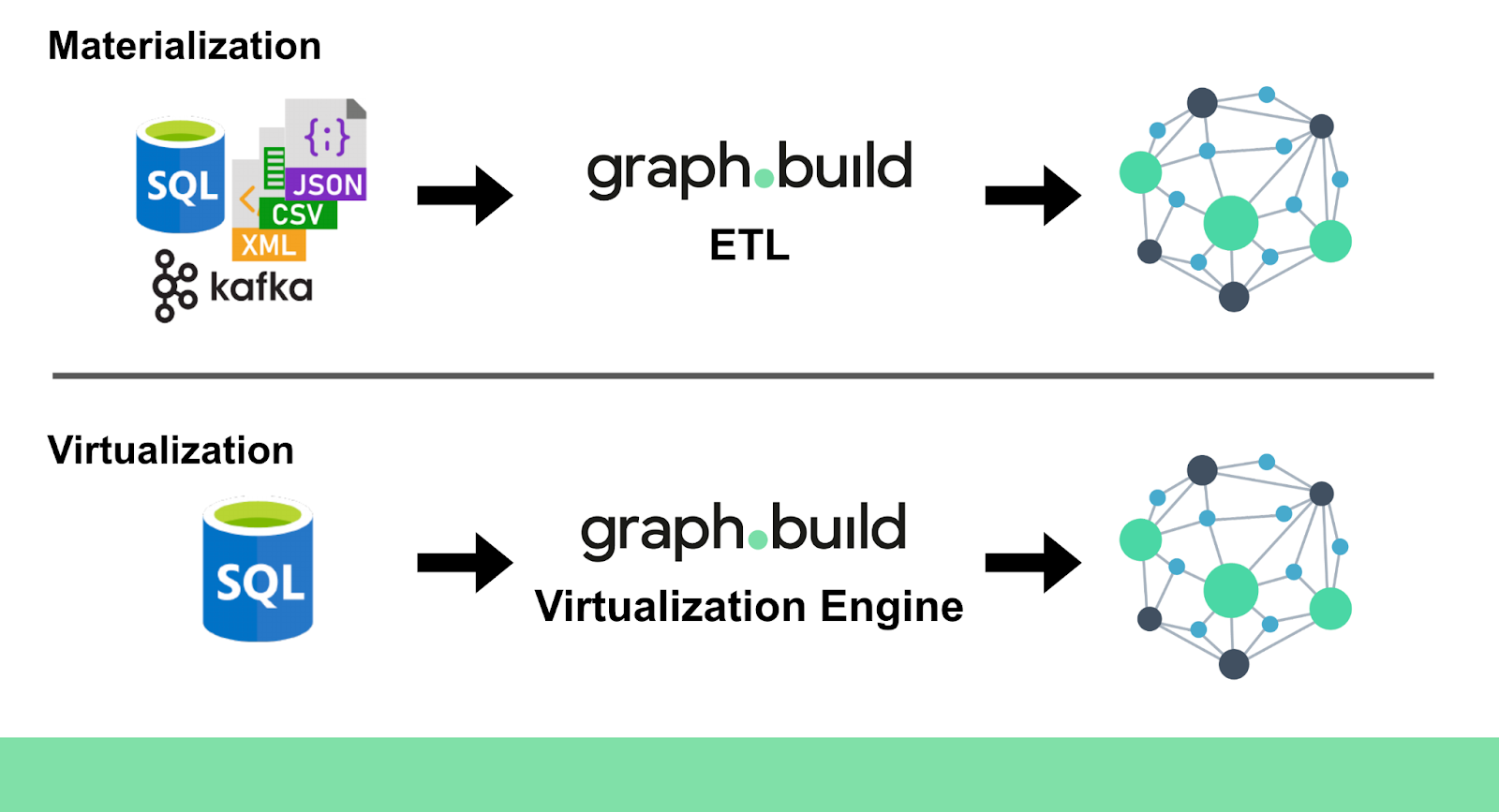In the world of graph technology, two approaches dominate the conversation when it comes to working with data: graph virtualization and graph materialization. Each method has unique strengths and is suited to different scenarios. At Graph.Build, we provide the flexibility to use either, depending on your needs. In this blog, we’ll explore what these approaches entail, how they differ, and how Graph.Build makes it easy to leverage both.

Graph Materialization
Graph materialization involves physically creating and storing a graph by importing data from various sources into a graph database. This process typically requires extracting data from relational databases, CSV files, or other data formats, transforming it into a graph structure, and loading it into the desired graph database.
Advantages of Materialization
- Performance: Queries can be executed quickly since the data resides in a graph-native format.
- Optimisation: Data is stored specifically for graph traversal and analysis, allowing for advanced indexing and faster graph algorithms.
- Persistence: Materialized graphs remain available even when the source data changes or becomes unavailable.
Challenges of Materialization
- Data Freshness: Materialized graphs may need frequent updates to reflect changes in source data, leading to potential maintenance overhead.
- Storage Requirements: Requires additional storage for the copied data.
Graph Virtualization
Graph virtualization, on the other hand, allows users to query and interact with graph data without physically replicating it. This approach creates a “virtual” graph by dynamically translating data from its source format into a graph structure at query time.
Advantages of Virtualization
- Efficiency: No need to replicate data, saving on storage and reducing redundancy.
- Real-Time Access: Always query the latest data directly from the source.
- Flexibility: Integrate multiple data sources without committing to a specific storage model.
Challenges of Virtualization
- Complexity: Requires robust query translation and integration mechanisms to handle diverse data formats effectively.
- Performance Overheads: Query performance may depend on the speed and capabilities of the underlying data sources.
With Graph.Build, You Can Do Both
At Graph.Build, we recognise that different use cases require different approaches. That’s why our platform supports both graph virtualization and materialization, giving you the freedom to choose the method that best suits your needs.
-
Graph Materialization: Whether you’re working with Semantic RDF or Labelled Property Graphs, use our intuitive ETL pipelines to seamlessly extract, transform, and load data into any graph database of choice. Not only does Graph.Build greatly simplify this process, it also addresses the biggest pain point of materialization - data freshness. By using our Change Data Capture (CDC) functionality or cron scheduler, you can always ensure your data is fully up to date with the source.
-
Graph Virtualization: Leverage Graph.Build Studio to query and analyse data directly from your relational databases, transforming it into a virtual graph on the fly. This is ideal for scenarios where data needs to remain in its original source or when testing new models without committing to storage. Graph.Build minimises the challenges of virtualization by massively reducing complexity. Build your model, connect to your database, and write SPARQL queries, all with the ability to make iterative changes at any stage.
By supporting and simplifying both approaches, Graph.Build ensures that you can balance performance, efficiency, and flexibility according to your unique requirements.
Whether you’re building persistent graph models through materialization or exploring dynamic, real-time insights with virtualization, Graph.Build has you covered. Our platform is designed to empower you with the tools and flexibility to tackle any graph data challenge.
Ready to get started? Visit our website to learn more, or try out Graph.Build today on AWS Marketplace or Docker Hub. If you’re curious about how Graph.Build can transform your data strategy, reach out to us for a demo.
Follow us on LinkedIn to stay updated with the latest innovations in graph technology!
About the Author
Russell Waterson is a Lead Software Engineer at graph.build, specialising in full-stack development with a focus on Knowledge Graphs, Linked Data, and the Semantic Web. With extensive experience in frontend, backend, and cloud technologies, Russell plays a key role in designing and implementing graph-based solutions that help organisations manage and transform their data more effectively.